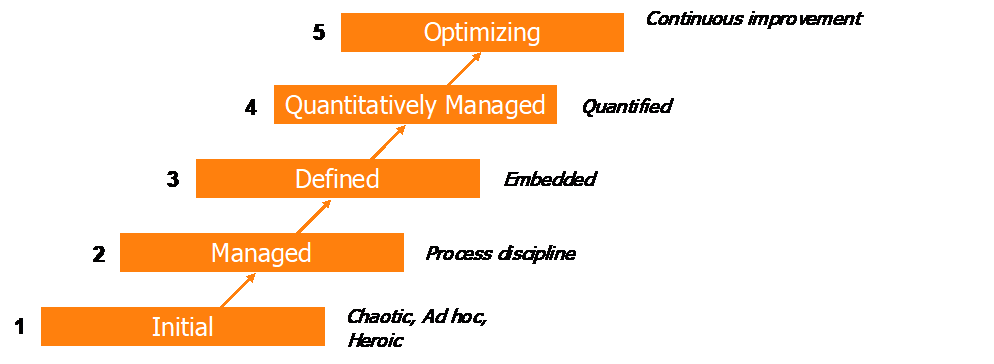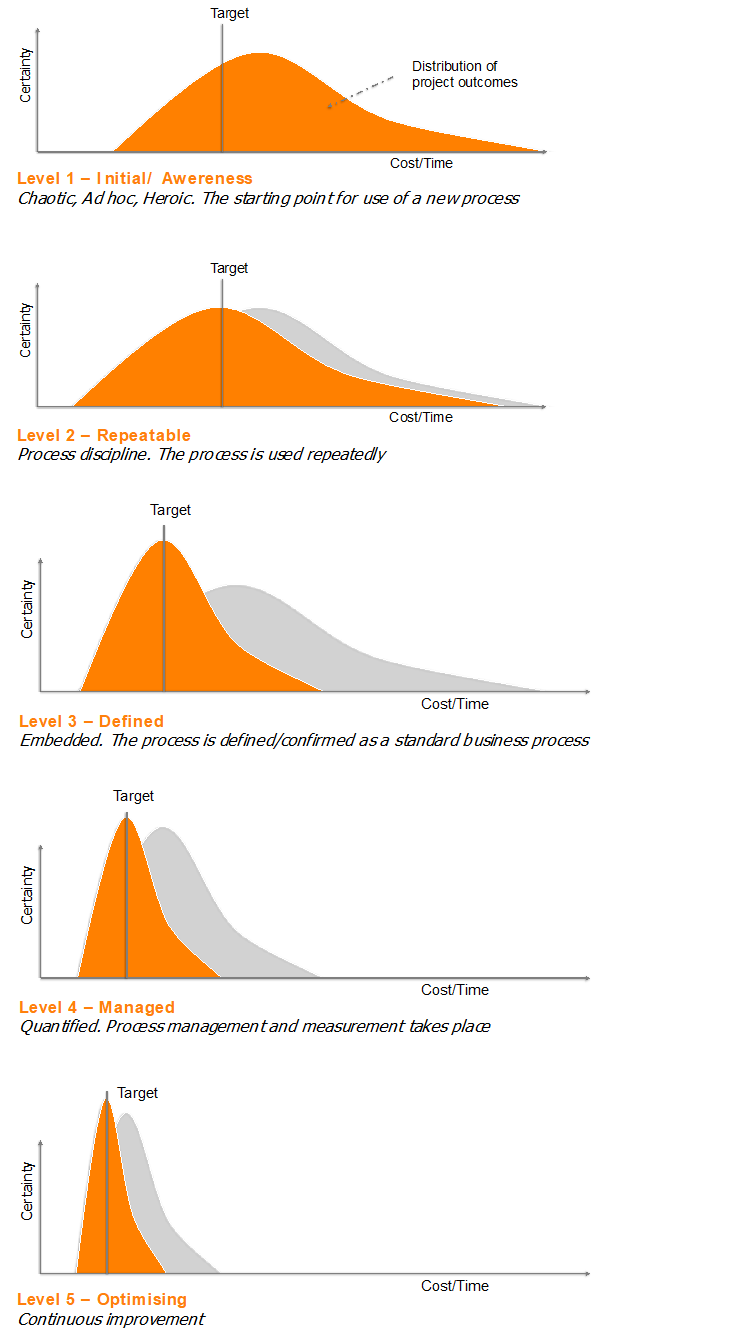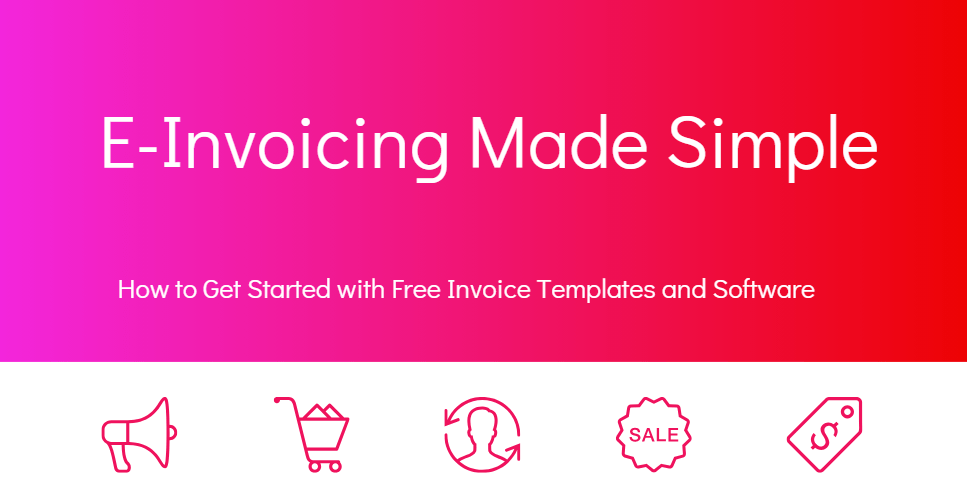The success rate of projects is still very low. If I look at the latest figures from the Standish Group (CHAOS 2020 – Beyond infinity)[1] 60% or more, depending on your approach (agile or waterfall) is not successful. This is already for several decades the case! So, to improve the performance of projects, you could look at the way your organization is doing projects. Or with other words how mature is your organization in doing projects? A well-known[2] maturity model is P3M3[3] from AXELOS. Here you will find p3m3 introduction and guide and p3m3 methodology examples.
Table of Contents
When you want to say something about maturity you must look at the standards an organization has set and how they apply those standards to their projects. If one project is using the standards and another project uses a different or no standard this is a signal the organization isn’t mature in project management. You could even go further and compare the results found with industry average figures by using the same maturity model to understand your strengths and weaknesses compared with competitors. I also used maturity models to compare different business units within the same organization to find spots for improvement in one business unit and used ways of working of a better performing business unit in the same area. In this case you don’t need absolute figures, but relative ones will work too.
Maturity levels
Firstly, most P3M3 methodology models in p3m3 introduction and guide use a scale to represent the (current or desirable) maturity level and are in line with 5 levels of Capability Maturity Model Integrated[4] (CMMI) as developed by the Carnegie Mellon University.
These maturity levels are:
- Level 1 – Initial: processes are unpredictable, poorly controlled, and reactive.
- Then, Level 2 – Managed: Processes are characterized for projects and is often reactive.
- Level 3 – Defined: Processes are characterized for the organization and is proactive. Projects tailor their processes from organization’s standards.
- Level 4 – Qualitatively managed: Processes are measured and controlled according to the p3m3 methodology.
- Level 5 – Optimizing: The focus is on process improvement.

These p3m3 maturity levels are a measure of an organization’s ability to deliver repeatable results – the higher up the curve the more predictable the outcome. In figure 1 we see the distribution of the project outcome by plotting the cost/time and certainty.

P3M3 introduction and guide: P3M3 methodology
The portfolio, programme, and project management maturity model (P3M3) measures an organization’s capability about its portfolio, programme, and project management practices. This measurement is expressed as a ‘maturity level’ which indicates an organization’s current capability in these practices.
An organization’s maturity is a measure of its ability to implement continuous improvement, and a maturity model, such as P3M3. It is a management tool that can be used to diagnose root causes, assess current capability, and demonstrate improvement. It also acts as a roadmap for achieving performance targets. P3M3 introduction and guide can be used independently of your chosen portfolio, programme, or project management method or framework.

P3M3 is broken down into three models: reflecting portfolio, programme, and project management. Each of these models has five maturity levels in line with the CMMI maturity levels.
These maturity levels are a measure of an organization’s ability to deliver repeatable results. Because the higher up the curve the more predictable the outcome. Hence, the P3M3 model looks for balance between processes, tools and people, at level 3 these are normally in balance and at level 4 they are becoming optimized and efficient.
But there are seven perspectives applicable within each of these models:
- Organizational governance: Deciding what projects/programmes/portfolios we want to do, and why
- Management control: Verifying that projects/programmes/portfolios progress as planned and within their authority
- Benefits management: Ensuring/proving that our projects/programmes/portfolios are/were worth doing in the eyes of the stakeholders
- Financial management: Getting and managing the budget to deliver
- Stakeholder management: Involving those who care and those who need to care
- Risk management: Managing uncertainty
- Resource management: Making sure we have the capacity to deliver.
Originally, Axelos offered both a limited self-assessment and a full assessment. The full assessment for an AXELOS Consulting Partner (ACP) to help you baseline your capabilities and focus on how to improve. The self-assessment (not offered anymore) was based on the seven perspectives and 3 threads (and are covered in the full assessment too, see next paragraph).
P3M3 methodology full assessment
P3M3 is a collection of Attribute Statements. There are:
- 3 Models
- 5 Levels
- 7 Perspectives
- 13 Threads
- 1 attribute statements per thread, perspective, level, model
- 1-10 diagnostic attribute statement per thread, perspective, level, model
In figure 4 a complete picture of P3M3 is given. As you can see it’s a complex model.
Firstly for introduction to P3M3, the top shows the three models and the five maturity levels. For each model there are 5 level descriptions to get a first understanding of the maturity level for each model. An organization could score a level 3 maturity for project management, a level 2 for portfolio management and a level 1 for programme management. When performing a P3M3 assessment you must choose which model you are going to use project or programme or portfolio management.
So, the next more detailed level is the inclusion of the seven perspectives. For each model and each perspective there are 5 level descriptions to get an understanding of the maturity of each perspective for a chosen model.
P3M3 full model
To use the model for a certification and or diagnostic assessment you need to include one or more of the 13 threads for introduction to P3M3:
- Asset management: This is the set of practices for assets in order to provide the level of service in the most cost-effective manner. It includes the management of design, construction, commissioning, operating, maintaining, repairing, modifying, replacing, and decommissioning/disposal of assets.
- Assurance: All of the systematic actions necessary to provide confidence that the target (system, process, organization, programme, project, outcome, benefit, capability, product output, deliverable) is appropriate.
- Behaviours: This covers the focus, motivation, and prioritization of work, and the team’s/individual’s commitment to achieving success within the perspective.
- Commercial management (Commissioner): This covers the commercial management activities (for example procurement) of a client who specifies work and commissions others to deliver it.
- Commercial management (Deliverer): This covers the commercial management activities (for example bidding) of a supplier who delivers work for clients.
-
Following Information Based Threads:
- Information and knowledge management: This covers how the organization captures, stores, organizes, and references information of any sort (this includes lessons, reports, document management, and guidance). In this way, the organization builds capability through the sharing of knowledge and experience.
- Infrastructure and tools: This covers the tools and systems used to manage and support a perspective. It could be as simple as a template, or as complex as an enterprise portfolio, programme, and project management system.
- Organization: This covers the structure, hierarchy, and competencies of people in relation to that perspective.
- Planning: Planning determines the end-porudct, how much it will cost, when it will be ready to deliver, how it will be available, and who will carry it out in the context of the perspective.
- Process: A process is a sequence of tasks to achieve an output.
- Standards: Standards (for example policies, rules, and categorization/classification) require conformance, and are a key part of P3M3.
- Techniques: These are the techniques to perform a process.
P3M3 Methodology Assesments
For a model certification assessment all perspectives and at least the threads standards, process, organization and information and knowledge management must pass with fully, partially, or rarely/never. If, for a specific perspective, the thread standards on level 3 is scored partially, it means that the score for the thread standards on level 2 must by fully otherwise it makes no sense to score level 3. At the end an average score, based on all threads, for each perspective can be clear. It will show an overview showing the perspectives and their levels which are fully, partially, or rarely/never completed. When using the Axelos online assessment tool, it’s possible to show the benchmark figures too. A final maturity score for a model is always the lowest maturity score of the seven perspectives.
It’s also possible to go for a further diagnostic assessment. Besides the thread level scores there are for each thread level within a perspective 2 to 10 diagnostic attribute statements to answer with applicable or needs improvement. As a result, it becomes clear where follow up actions are for achieving a higher level of maturity. These can be priority and translate into an improvement plan.
But the self-assessment works slightly different. For each perspective there are three threads organization, process, and performance. So, each thread has 5 reflective level statements to select the right one. The average of the three gives the maturity score for that specific perspective as written in p3m3 introduction and guide.
Conclusion on introduction to P3M3
Consequently, a P3M3 methodology assessment has several advantages.
- It can help to convince senior management to continue with portfolio, programme, or project capability improvement.
- Also this independent certification demonstrates to an organisation’s external stakeholders or clients that they have a portfolio, programme, or project capability.
- A mature portfolio, programme, or project capability is more likely to meet the goals and intent of your strategic initiatives.
References
[1] https://www.standishgroup.com
[2] https://hennyportman.wordpress.com/2022/02/12/project-management-maturity-and-excellence-models-stirring-in-the-fruit-bowl/ offers more than 50 different maturity models
[3] AXELOS (2021). P3M3 Overview. Version 3. Axelos, London, UK

Henny Portman, owner of Portman PM[O] Consultancy and was partner of HWP Consulting, has 40+ years of experience in the project management domain. He was the project management office (PMO) thought leader within NN Group and responsible for the introduction and application of the PMO methodologies (portfolio, program, and project management) across Europe and Asia. He trains, coaches, and directs (senior) programme, project and portfolio managers and project sponsors at all levels, and has built several professional (PM(O)) communities.
Henny Portman is/was accredited in a variety of qualifications, including P3O, PRINCE2, MSP, MoP, PRINCE2 Agile, AgilePM, AgilePgM and AgileSHIFT trainer and an SPC4 SAFe consultant and trainer. He is a P3M3 trainer and assessor and PMO Value Ring Certified Consultant (PMO Global Alliance). On behalf of IPMA, he assesses mega and large projects for the IPMA Project Excellence Award. In addition to this, he is an international speaker, author of many articles and books in the PM(O) field, and an active blogger

















